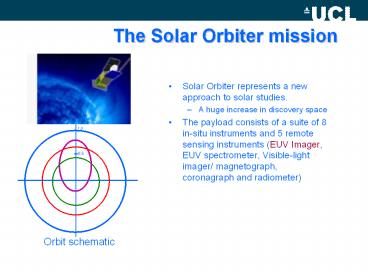The Solar Orbiter mission - PowerPoint PPT Presentation
Title:
The Solar Orbiter mission
Description:
The payload consists of a suite of 8 in-situ instruments and 5 remote sensing ... EUV spectrometer, Visible-light imager/ magnetograph, coronagraph and radiometer) ... – PowerPoint PPT presentation
Number of Views:11
Avg rating:3.0/5.0
Title: The Solar Orbiter mission
1
The Solar Orbiter mission
- Solar Orbiter represents a new approach to solar
studies. - A huge increase in discovery space
- The payload consists of a suite of 8 in-situ
instruments and 5 remote sensing instruments (EUV
Imager, EUV spectrometer, Visible-light imager/
magnetograph, coronagraph and radiometer)
Orbit schematic
2
(No Transcript)
3
Slow and fast solar wind
4
The solar cycle variation of the solar wind
5
The engineering challenge
- Solar Orbiter is a specially designed three-axis
stabilised spacecraft. - It is designed to always point its smallest face
to the Sun so the spacecraft is protected by a
sunshield. - At closest approach to the Sun, Solar Orbiter
will receive 25 times the radiation per square
metre that the Earth does. - The spacecraft will also be kept cool by the
positioning of special 'radiators', which will
dissipate excess heat into space.
6
An Imager for Solar Orbiter
The Solar Orbiter mission is a key mission for
solar system science.
- Fundamental physical processes (waves/magnetic
reconnection/dynamo) - Linking the Sun and the inner heliosphere
- Exploring the solar atmosphere out of the
ecliptic (slow and fast solar wind)
7
Fundamental physical processes
G-band
Ca II
- We can, with excellent seeing, resolve 70 km in
the photosphere with a ground-based telescope. - SO will allow us to do better than this even in
the corona! (and more than an order of magnitude
better than currently possible e.g. TRACE 750km). - At this resolution we will be able to observe MHD
waves and reconnection at the fundamental
physical scales.
Rutten et al., 2003
3-D modelling showing the interaction between
magnetic field and convection
Cattaneo, Emonet and Weiss, 2003
8
Observing up close
- This resolution will allow us to observe magnetic
loops at their fundamental size. - The smaller the scale, the more (rapid) activity
we observe (TRACE observes with time resolution
of seconds).
?
Factor of 100
Factor of 5
9
Linking up with in situ
10
Current Status
- The current schedule is for the AO to be released
in 2007 (ish). - Call for Letters of Intent to Propose for the
Solar Orbiter payload in advance of the formal AO
(this summer!). - The launch date is now most likely 2017 - with
4.5 yrs to get into orbit. - We have been working here on technology
development for the mission for several years -
this will continue!































